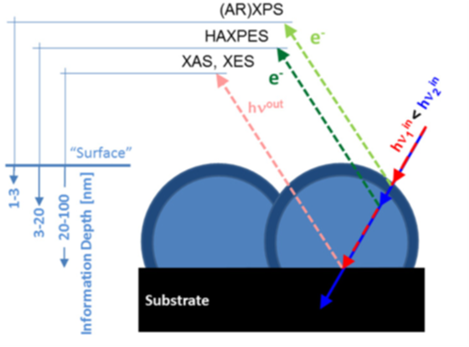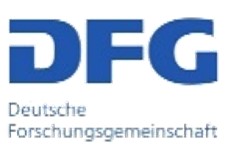Department Interface Design
GaPt alloys for Supported Catalytic Active Liquid Metal Solutions (SCALMS)
The collaborative Research Centre (CRC) 1452, Catalysis at Liquid Interfaces (CLINT), follows a new paradigm exploring the highly dynamic, anisotropic environment of liquid interfaces to create, tailor, and stabilise catalytically active sites with unique reactivity and performance. Within that concept our group is interested in fundamental properties e.g., the electronic and chemical structure of active phases of Supported Catalytically Active Liquid Metal Solutions (SCALMS). Towards the goal of providing a full ‘depth-resolved’ picture of SCALMS catalysts; we will study candidate material systems over a wide range of complexities, i.e., from model to real-world catalysts.
Sketch of a SCALMS droplet on a support material like silica and fundamental aspects: blue spheres are representative of the matrix material; red spheres represent the active metal.
Using different laboratory and synchrotron-based X-ray spectroscopic techniques, we will differentiate surface (or nearsurface) from bulk properties, conduct experiments in a variety of sample environments (from UHV to near-ambient pressure to technical operation conditions) to identifying the state of the catalyst and the properties of the active site. Typical samples are supported Ga alloy nanoparticle model systems produced under UHV conditions as well as real-world catalysts with differing compositions including binary and ternary alloys. Our studies will reveal insights into the SCALMS concept, ranging from information on wetting/dewetting phenomena on the catalyst support to the concentration of the active site on the liquid metal surface as well as its electronic and chemical properties in vacuum and in a reactive environment, specifically addressing (among others) how educt adsorption, deactivation, and reaction conditions or synthesis routes affect the SCALMS properties.
Scheme of the spectroscopic techniques available and their information depth when applied to a model SCALMS catalyst.
More details can be found in:
T.-E. Hsieh, J. Frisch, R. G. Wilks, M. Bär, Unravelling the Surface Oxidation-Induced Evolution of the Electronic Structure of Gallium, ACS Appl. Mater. Interfaces 15 (2023) 47725-47732. https://doi.org/10.1021/acsami.3c09324
T.-E. Hsieh, S. Maisel, H. Wittkämper, J. Frisch, J. Steffen, R. G. Wilks, C. Papp, A. Görling, M. Bär, Unraveling the Effect of Rh Isolation on Shallow d States of Gallium–Rhodium Alloys, The Journal ofPhysical Chemistry C 127 (2023) 20484-20490. https://doi.org/10.1021/acs.jpcc.3c04350
T.-E. Hsieh, J. Frisch, R. G. Wilks, C. Papp, M. Bär, Impact of Catalysis-Relevant Oxidation and Annealing Treatments on Nanostructured GaRh Alloys, ACS Applied Materials and Interfaces (2024).https://doi.org/10.1021/acsami.4c02286
H. Wittkämper, R. Hock, M. Weisser, J. Dallmann, C. Vogel, N. Raman, N. Taccardi, M. Haumann, P. Wasserscheid, T. E. Hsieh, S. Maisel, M. Moritz, C. Wichmann, J. Frisch, M. Gorgoi, R. G. Wilks, M. Bär, M. Wu, E. Spiecker, A. Görling, T. Unruh, H.-P. Steinrück, C. Papp, Isolated Rh atoms in dehydrogenation catalysis, Sci. Rep. 13 (2023) 4458. https://doi.org/10.1038/s41598-023-31157-y




